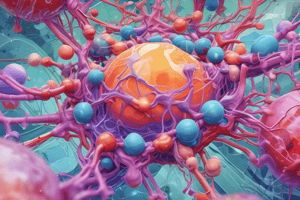Podcast
Questions and Answers
What is the main purpose of apoptosis in hematopoiesis?
What is the main purpose of apoptosis in hematopoiesis?
- To remove aged and defective cells (correct)
- To increase cell division
- To produce new cells
- To stimulate cell growth
Which type of leukemia affects B lymphocytes and typically occurs in adults over 50 years old?
Which type of leukemia affects B lymphocytes and typically occurs in adults over 50 years old?
- Acute myelogenous leukemia
- Chronic lymphocytic leukemia (correct)
- Hairy cell leukemia
- Acute monocytic leukemia
What is the function of growth factors in hematopoiesis?
What is the function of growth factors in hematopoiesis?
- To stimulate apoptosis
- To reduce WBC count
- To signal hematopoietic tissue to produce specific cell types (correct)
- To inhibit cell growth
Which component of hemoglobin is responsible for carrying oxygen?
Which component of hemoglobin is responsible for carrying oxygen?
What is a key factor in determining the prognosis of chronic myelogenous leukemia?
What is a key factor in determining the prognosis of chronic myelogenous leukemia?
Where does hematopoiesis occur in adults?
Where does hematopoiesis occur in adults?
Which of the following is a characteristic of benign tumors?
Which of the following is a characteristic of benign tumors?
What is the primary cause of pernicious anemia?
What is the primary cause of pernicious anemia?
What is the hallmark of sickle cell anemia?
What is the hallmark of sickle cell anemia?
What is the primary difference between Hodgkin lymphoma and non-Hodgkin lymphoma?
What is the primary difference between Hodgkin lymphoma and non-Hodgkin lymphoma?
What is the most common type of leukemia in children?
What is the most common type of leukemia in children?
What is the treatment for pernicious anemia?
What is the treatment for pernicious anemia?
What is the prognosis for chronic myeloid leukemia?
What is the prognosis for chronic myeloid leukemia?
What is the primary manifestation of aplastic anemia?
What is the primary manifestation of aplastic anemia?
What is the primary difference between macrocytic anemia and megaloblastic anemia?
What is the primary difference between macrocytic anemia and megaloblastic anemia?
What is the treatment for sickle cell anemia?
What is the treatment for sickle cell anemia?
What type of hypersensitivity reaction is characterized by a delayed response and involvement of T cells?
What type of hypersensitivity reaction is characterized by a delayed response and involvement of T cells?
What is an example of tertiary prevention?
What is an example of tertiary prevention?
What is the main risk associated with uncontrolled hypertension?
What is the main risk associated with uncontrolled hypertension?
What is an example of a primary prevention strategy?
What is an example of a primary prevention strategy?
What is the characteristic of Type 4 hypersensitivity reaction?
What is the characteristic of Type 4 hypersensitivity reaction?
Why is it important to check blood pressure regularly?
Why is it important to check blood pressure regularly?
Flashcards are hidden until you start studying
Study Notes
Tumors
- Benign tumors: slow-growing, well-defined capsule, non-invasive, well-differentiated, low mitotic index, no metastasis
- Malignant tumors: fast-growing, not encapsulated, invasive, poorly differentiated, high mitotic index, able to metastasize
Anemias
Pernicious Anemia
- Autoimmune disorder: anti-IF or anti-parietal cell antibodies
- Manifestations: bleeding gums, diarrhea, impaired smell, loss of deep tendon reflexes, anorexia, personality or memory changes, positive Babinski's sign, stomatitis, paresthesia, and unsteady gait
- Diagnosis: CBC, serum B12 levels, antibody presence, gastric analysis, folate (Schilling's test, bone marrow biopsy)
- Treatment: injectable B12 (bypassing GI tract absorption)
Megaloblastic Anemia
- Folate and VitB12 are required for DNA synthesis, leading to decreased maturation and cell division
- Causes: decreased intake from diet, gastric dysfunction, celiac sprue, autoimmune (anti-IF or anti-parietal cell antibodies)
- May see myelin breakdown and neurological complications
Macrocytic Anemia
- Characterized by large red blood cells
Aplastic Anemia
- Pancytopenia: bone marrow depression of all blood cells, damage to PSC
- Causes: insidious, other anemias, autoimmune, medications, medical treatments, viruses, cancer, and genetic
- Onset may be insidious or sudden and severe
- Manifestations: anemia, leukocytopenia, thrombocytopenia
- Diagnosis: complete blood count and bone marrow biopsy
- Treatment: identify and manage underlying cause, oxygen therapy, infection control and treatment, bleeding precautions, blood transfusions, and bone marrow transplants
Sickle Cell Anemia
- Autosomal recessive inheritance, abnormal hemoglobin "S" (one AA substitution)
- HgbS causes RBC to become abnormally shaped/sickled under low oxygen conditions, leading to tissue hypoxia and ischemia
- More common in people of African and Mediterranean descent
- Manifestations: appear as early as 6 months of age, sickle cell crisis, painful episodes, tissue ischemia and necrosis, triggered by dehydration, stress, infection, high altitudes, and fever
- Diagnosis: CBC, sickle solubility (screen), hemoglobin electrophoresis, CMP
- Treatment: no cure, palliative, exceptions: stem cell or bone marrow transplant, gene therapy under research
Hemolytic Anemia
- Excessive erythrocyte destruction, reticulocyte production index is high
- Causes: idiopathic, autoimmune, genetics, infections, blood transfusion reactions, and blood incompatibility in the neonate
- Several types: hemoglobinopathies (sickle cell anemia), thalassemia, RBC membrane or enzyme defects, immune (erythroblastosis fetalis) and non-immune hemolytic anemia
Lymphomas
- Cancers originate in lymphatic system, affecting WBCs as well
- Most common hematologic cancer in the US
- Two main types:
- Hodgkin lymphoma: B cells
- Non-Hodgkin lymphoma: B cells, T cells, NK cells
Hodgkin Lymphoma
- Lesser common of the two
- Solid tumors with the presence of Reed-Sternberg cells
- Typically originate in the lymph nodes of the upper body
- Several subtypes
- Amenable to cure
- Manifestations: painless enlarged lymph nodes, weight loss, fever, night sweats, pruritus, coughing, difficulty breathing, chest pain, recurrent infections
- Diagnosis: physical examination, presence of Reed-Sternberg cells in a lymph node biopsy, CBC, chest X-rays, CT-scan, MRI, PET scan, and bone marrow biopsy
- Treatment: chemotherapy, radiation, and surgery
Non-Hodgkin Lymphoma
- More common
- Poor prognosis
- Many different types
- Similar to Hodgkin manifestations, staging, and treatment
- Different in the spread and diagnosis
- Can originate in the T or B cells
- No Reed-Sternberg cells
Leukemia
- Manifestations: leukopenia, leukocytosis, anemia, thrombocytopenia, lymphadenopathy, joint swelling, bone pain, weight loss, anorexia, hepatomegaly, splenomegaly, and central nervous system dysfunction
- Diagnosis: H&P, CBC with peripheral blood smear, and bone marrow biopsy
- Treatment: chemotherapy and bone marrow transplant
Chronic Myeloid Leukemia
- Affects primarily adults
- Responds poorly to chemotherapy, but prognosis is improved with allogenic bone marrow transplant
Acute Lymphocytic Leukemia
- Affects young children
- Best prognosis is found in children between 1 and 9 years of age; infants and adolescents respond less positively to chemotherapy
Acute Myelogenous Leukemia
- Affects adults
- Chemotherapy is less successful in adults with AML, although remissions may be achieved
Chronic Lymphocytic Leukemia
- Affects adults >50 years
- Prognosis is often related to the WBC count and the proportion of blast cells present at the time of diagnosis
Hairy Cell Leukemia
- Affects males >50 years
Hemoglobin Structure
- Globin group: surrounded by the four heme groups
- Heme groups: ring-like organic compounds called porphyrins with an iron atom attached
- Protein chains: two alpha chains and two beta chains, each with a heme group
Studying That Suits You
Use AI to generate personalized quizzes and flashcards to suit your learning preferences.




